Good Morning, Good Morning! Today, I want to touch on a topic that MANY of you have been asking about. Sunscreen containing the toxic 3 O’s (oxybenzone, octinoxate and octocrylene) is actually illegal in the US Virgin Islands thanks to legislature that was passed in March of 2020. It is unlawful to use, possess, import or sell a sunscreen containing any of these active ingredients in the territory. Now, no one is necessarily going to hunt you down and throw you in jail for having a bottle of Coppertone in your backpack. But, you COULD run into a hefty fine ($1000 for the first offense and $2000 for the second!). And, hey, if it isn’t good for the reefs, it probably isn’t good for you. So, let’s take a look at some sunscreens that are safe for you AND safe for our sea life!
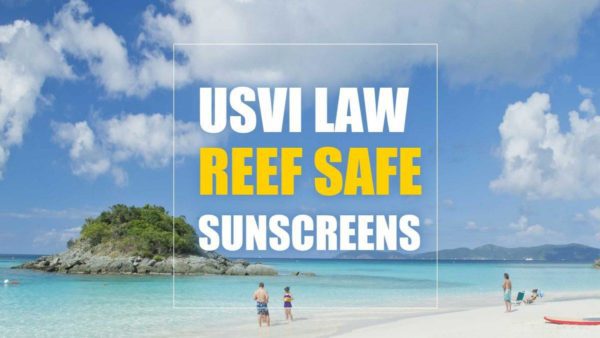
First, let’s take a closer look at this act that went into effect on March 30, 2020.
Basically, it outlaws the use/possession, import, sale and/or distribution of any “sunscreen” product that contain any of the O words listed above. Why? Because these chemicals, according to the legislation, “have significant harmful impacts on the Virgin Islands marine environment and eco system.”
And, if you snorkeled here 20 years ago and then again more recently, you have probably noticed the amount of dead or dying coral surrounding our shorelines. Now, I’ll agree, some of this may likely be from the impacts of storms, some from the rising water temperatures and climate change. But, I’m willing to bet that the 2 million plus annual visitors to the USVI each year who are, perhaps unknowingly, sporting these reef toxic chemicals probably have not helped over the years. But, now we all know and onward and upward…Let’s start fresh in the right direction!
“These chemicals are at 40 times acceptable levels in some of our territorial waters. This simply cannot be,” said Senator Janelle Sarauw, a sponsor of the bill. “This ban protects the environment, our health and our livelihood. But equally important to laws is building awareness of the dangers of these chemicals vs. safer alternatives such as mineral sunscreens. Everyone must do their part.”
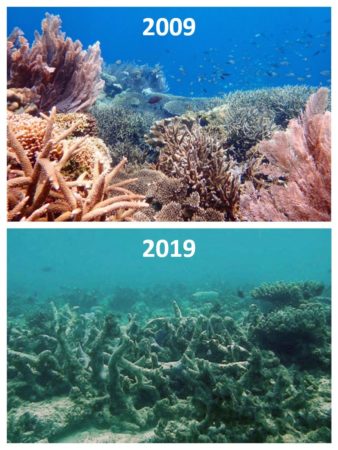
And, while there are several different Coral Restoration Projects currently underway in the USVI, it is imperative that we all start keeping these chemicals out of our waters now. You know, so the restoration works and we can start seeing those beautiful colors flourishing under the sea once again.
Now, I totally understand the daunting nature of choosing the RIGHT sunscreen both for your skin and for the environment. I have tried soooooooo many different types of “reef safe” sunscreen. I, too, have been duped by the dishonest “reef friendly” labels on something that looks safe and smells delicious 🙂 And, the chalky white film all over your skin? While it’s generally effective, no one wants that while they’re adorning their new swimwear on the beach.
So, first things first—Know your labels! Check the active ingredients on the bottle. The sunscreen should be a non-nano mineral sunscreen containing zinc oxide and titanium dioxide. If there is anything other than these two items listed under the active ingredients, keep shopping.

And, if you see the following words anywhere on the ingredients list…You guessed it, keep shopping 🙂
- Oxybenzone
- Octinoxate
- Octocrylene
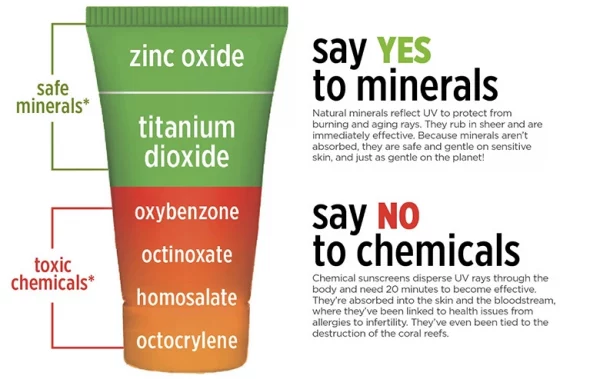
To further assist in your sunscreen selection, Island Green Living Association (You know, the folks who brought us the ReSource Depot, plastic and aluminum recycling, etc.) have a developed a pretty awesome list of providers who offer a great product. And, they are totally safe for both you AND the reefs! I’ll weigh in honestly on a couple of the products on this list as well, based on my personal use.

If you have taken a look at the links in the above paragraph by now, great! You’re already on the right track. Here are a few of my personal picks:
Stream to Sea – While this one does rub on a bit chalky, it does a heck of a job of protecting from the sun AND wears well in the water. It would be a great one for the kiddos if your little ones are water babies!
Bare Republic – This was one of my first favorite Reef Safe brands. They donated literal PALLETS of the stuff after Irma and I had several bottles of it on hand. It rubs in relatively well and the purplish hue only lasts for as long as it takes to absorb. Technology has advanced over the past five years though and I have found others that feel a little nicer on the skin. But, overall, Bare Republic is a solid pick. Oh, let me just warn you…They offer a lot of spray sunscreens that, while they are reef safe, they are not boat safe. They have added pigmentation that does not do nice things for boat decking. So, reef safe or not, stick to the lotions, not sprays, for your boat days!
Australian Gold– Their botanical mineral sunscreen is my ABSOLUTE favorite. It goes on smooth, has 80 minutes of water proof protection AND it smells like an absolute dream. Like you’re walking through a field of flowers. I’d advise reapplying after each dip, but you won’t mind because it rubs in so nicely and again…The smell! Oh, and it contains antioxidants from Kakadu Plum, Eucalyptus and Red Algae. So you can go ahead and use this one all over your face as well.
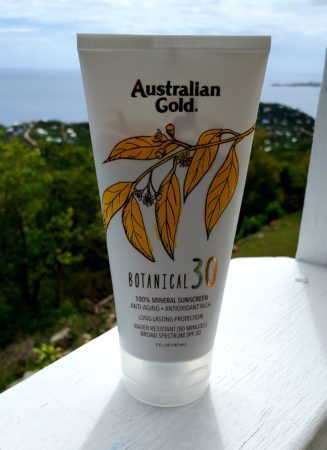
That’s it for the ones on this particular list for the brands that I have tried personally. But please take a look at the rest of the brands listed on Island’ Green’s sunscreen list via the QR code below. This list and the corresponding QR code should be appearing soon on the USVI Department of Tourism’s website, according to the President of Island Green’s Board of Directors, Harith Wickrema.

Another neat little sunscreen tool I found while researching some things for this article is Environmental Working Group’s Guide to Sunscreens. It’s an absolutely awesome database that rates sunscreens based on health concerns, UVA/UVB Balance and the full list of ingredients. You can search by top rated types of sunscreen OR type in the name of a product you are pondering to see the breakdown. Now, it’s not fail safe because the database DOES contain NON reef safe brands and types. But, it might be a good deciding factor if you are going back and forth between a few products while making a purchase.
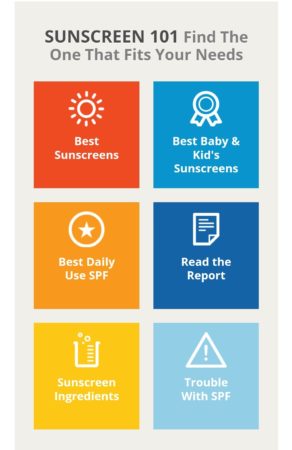
In a nutshell folks, world wide, coral reefs only make up 1% of the overall ocean floor. But 25% of the life in the ocean relies on these reefs. They are vital to protecting coastlines and supporting life in oceans and have the highest biodiversity of any of the planet’s eco-systems. By insisting that we take care of our reefs, the USVI is looking out for the future of the entirety of our surrounding marine environment.
Oh, and if you’re a nerd about the ocean, like myself, and are interested in learning more about the importance of coral reefs and the preservation of them, I would highly recommend watching Chasing Coral if you haven’t already. It’s an incredibly eye opening documentary about just how important coral is to the underwater world. And how quickly it can die.


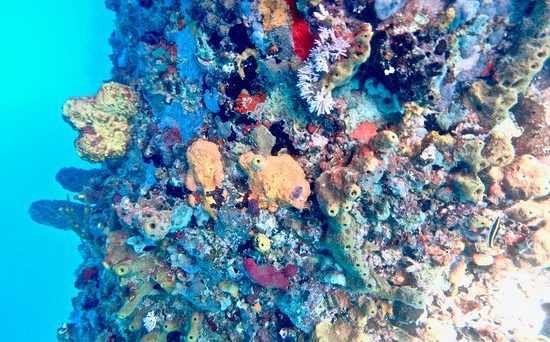
Who sales Australian Gold on St John?
I don’t know but if you’re still stateside, it’s sold on Amazon and Target.com with next day delivery.
As bad as I dislike the mineral sunscreens, I really hate to see what has happened to the reefs over the past 10 or 15 years. As you’ve pointed out, a lot is due to storms, but dumping gallons of toxic sunscreen in the water isn’t helping either. If 2 million people come to the island a year and each one uses a bottle of sunscreen per visit, that’s almost 5,500 bottles of sunscreen dumped in the water DAILY (yes, I understand everyone doesn’t sit in the water the entire time, but you get the point, it’s a lot).
Many people ask which brand is best and you see so many responses, just go buy a few and try them out at home before you head out to see which product works best for you. I haven’t tried the Australian Gold, but I’ll look for it before our next trip!
Target has a wide range of the coral friendly lotions!
I believe Badger is safe.